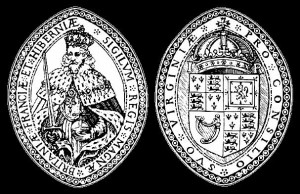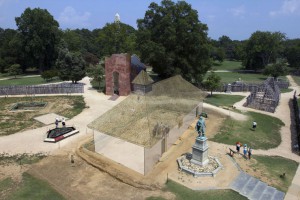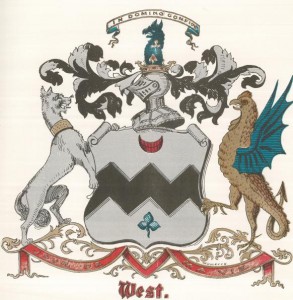 Seal of the King of England, Scotland, Ireland, and France, as President of the Virginia Council. U.S. National Parks Service
Seal of the King of England, Scotland, Ireland, and France, as President of the Virginia Council. U.S. National Parks Service
The announcement Tuesday of the (probable) identification of the remains of four men buried under the chancel of the first parish church at Jamestowne, Virginia – first discovered in 2010 and unearthed in 2013 – has now made the front page of The Wall Street Journal and appeared in other leading news outlets. While not the first Englishmen to die in the nascent American colony, they were nearly so, probably interred in Virginia soil in 1608 and 1610, more than a decade before the Mayflower arrived on American shores; these men were certainly among the colony’s founders.
 Representation of the first Jamestowne parish church. The ruins of the later parish are above and to the left of the earlier structure. The remains were buried under the chancel, before the altar. Jamestowne Rediscovery
Representation of the first Jamestowne parish church. The ruins of the later parish are above and to the left of the earlier structure. The remains were buried under the chancel, before the altar. Jamestowne Rediscovery
The Reverend Robert Hunt, whose identity seems the most certain, was the first pastor of the Anglican parish at Jamestowne. Burial in the chancel, or elsewhere in the parish church, was and remains customary for founding pastors, although this burial seems as likely because his death occurred so far from his home in England. Assigned to Virginia from the parish of Heathfield in Sussex in 1606, he arrived with the first settlers in 1607, and his pastoral service extended through early 1608. His will was probated in England in the summer of 1608. Hunt left two children, a son and a daughter, in England.
Captain Gabriel Archer was also a major figure in the earliest years at Jamestowne. Because of the presence of a reliquary, identifying the remains as those of a probable Catholic (or crypto-Catholic ),[1] his prominent role as a chronicler of the early colony, service as secretary and councilor, and highborn status at home in Essex, his identification is also nearly certain. Archer died before the end of the “Starving Time” between 1609 and the summer of 1610. While he did not have lineal descendants, near kinsmen did, and his brother, John Archer, inherited his stockholdings in the Virginia Company.
Sir Ferdinando Wainman (Wenman, Weyman) was a stockholder in the Virginia Company who arrived with the governor, Thomas West, 3rd Baron De La Warr (or Lord Delaware), in June 1610. While most articles say he was a relative of Lord De La Warr, he was specifically a first cousin, the son of Jane West, youngest child of William West, 1st Lord De La Warr. He was, like Archer, a member of the Virginia Council, and he rendered other service to the colony. He died later in 1610, and George Percy (son of the Earl of Northumberland), Lord De La Warr’s predecessor and successor as governor, lamented the passing of this “honest and valiant gentleman.” The Records of the Virginia Company also demonstrate that a later patent was awarded to Sir Thomas Weyman.
 Captain William West may have been a close relative of the 3rd Lord De La Warr, though given his probable age it does not seem likely he was the younger brother of the 2nd Lord named William West. Many Americans and Britons alike can trace their ancestry to this family. While the 3rd Lord De La Warr left many descendants in Britain, only his younger brother John West left traceable descendants in Virginia, the author of this article among them.[2] A potential path toward definitively proving the identification of William West would be to test recoverable DNA against the y-DNA of a patrilineal kinsman. In any case, the William West who was probably buried under the chancel was killed in combat with Indians at the Falls of the James in 1610.
Captain William West may have been a close relative of the 3rd Lord De La Warr, though given his probable age it does not seem likely he was the younger brother of the 2nd Lord named William West. Many Americans and Britons alike can trace their ancestry to this family. While the 3rd Lord De La Warr left many descendants in Britain, only his younger brother John West left traceable descendants in Virginia, the author of this article among them.[2] A potential path toward definitively proving the identification of William West would be to test recoverable DNA against the y-DNA of a patrilineal kinsman. In any case, the William West who was probably buried under the chancel was killed in combat with Indians at the Falls of the James in 1610.
Some more in-depth coverage of the burial site and the several remains has been prepared by the Smithsonian Institution and includes the four graves, the whole burial site, and the reliquary:
- The Jamestowne Church Chancel Burial Site
- The Grave of Reverend Robert Hunt
- The Grave of Captain Gabriel Archer
- The Reliquary Buried with Captain Archer
- The Grave of Sir Ferdinando Wainman/Wenman/Weyman
- The Grave of Captain William West
Notes
[1] The reliquary is of particular interest as the earliest sacred object of its type recovered in Virginia. It is uncertain what degree of relic it contains, but a member of the English gentry at the dawn of the seventeenth century could have possessed something very remarkable.
In the late 1500s, Pope Gregory XIII declared 63 English and Welsh martyrs venerable. Many of them were later beatified and ultimately canonized by Popes Pius XI and Paul VI. It is not unreasonable to suggest that the reliquary might well contain a remnant of one of these saints who could even have been a close relative of Captain Archer. Certainly, the Calverts, Lords Baltimore, the Howards, Lords Arundel, the Gerards, and others in early Maryland had near relatives among the Martyrs of England and Wales. Perhaps genealogical enquiries into Archer’s ancestry and kin will make the meaning of the “M” on the reliquary apparent.
[2] Like the West family of Virginia, the Pelham family of New England and New York descends from Lady Mary Boleyn, grandmother of Anne Knollys, wife of the 2nd Baron De La Warr.
Share this:
About Christopher Carter Lee
Christopher Carter Lee completed undergraduate studies in international relations at Georgetown University in Washington, D.C., where he focused on culture and politics. He previously worked in foreign policy research, special projects and development for a U.S. Senate office, and as a political consultant, appearing on CNN's Crossfire. More recently, he built his own hired genealogical research practice while consulting in program development before joining NEHGS Research Services. He holds a Certificate in Genealogical Research from Boston University and has extensive knowledge of Maryland, Virginia, Southern U.S., and Southeastern American Indian genealogy, the Catholic Church in North America, and expertise in Italian, French, Polish, Russian, and other European research, nobility, heraldry, and history.View all posts by Christopher Carter Lee →